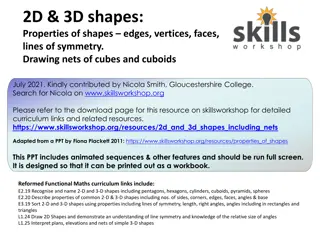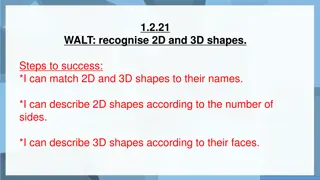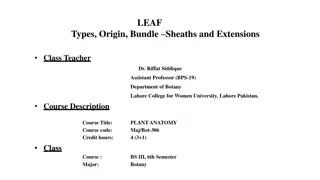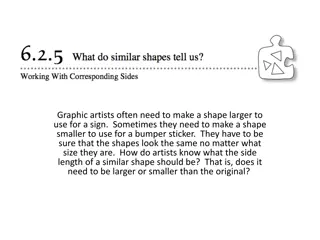Understanding Leaf Anatomy: Bud Scales to Leaf Apex Shapes
The article delves into the intricate structures of plant leaves, from bud scales that protect vegetative buds to sharp spines guarding against herbivores. It explains the leaf blade's composition, detailing the mid-rib, veins, margin, and apex. Various leaf apex shapes are explored, including obtuse, acute, acuminate, long rigid sharp point, and truncate, with examples provided for each type.
Download Presentation

Please find below an Image/Link to download the presentation.
The content on the website is provided AS IS for your information and personal use only. It may not be sold, licensed, or shared on other websites without obtaining consent from the author. Download presentation by click this link. If you encounter any issues during the download, it is possible that the publisher has removed the file from their server.
E N D
Presentation Transcript
Bud scales these are scaly stipules which enclose and protect the vegetative buds and fall off as soon as the leaves unfold e.g. Ficus sp., Mussanga sp.
two sharp pointed structures known as spines, one on each side of the leaf base. They protect the leaf against grazing by herbivorous animals e.g. Mimosa sp., Acacia sp.
blade from its base to the apex. The mid-rib produces thinner lateral veins which in their turn give rise to still thinner veins or veinlets. The edge of the lamina is known as the leaf margin and the tip is called the leaf apex. The major function of the lamina is photosynthesis.
Leaf Apex is the tip of the leaf blade and it could be of various shapes. The various types are described below:
Obtuse or round apex is blunt or rounded e.g. Terminalis catapa, Talinum triangulae etc.
Acute Apex: the tip of the leaf is pointed and sharp in the form of an acute angle eg. Sida acuta
Acuminate apex: the leaf tip tapers to a long slender structure, which may be either acute or blunt, e.g. Ficus religiosa.
long rigid sharp point. It is similar to acuminate, but there is no abrupt constriction before tapering to a long slender structure e.g. Date palm, Pineapple.
Truncate apex: the apex ends abruptly as if cut off in a straight line e.g. Indian sago palm (Caryota urens).
Retuse apex: when the leaf apex is furnished with a shallowly notch i.e. The apex is shallowly depressed e.g. Pistia (water lettuce).
Emerginate apex: this is similar to retuse apex, but the notch or depression is deeper and more pronounced than in retuse e.g. Bauhinia sp. Oxalis sp.
Mucronate apex is round but ends in a short point, looking as if the mid-rib is projected further above the apex e.g. Ixora sp.
Apiculate apex: the rounded apex is topped by a short point that is smaller than the one in mucronate.
Cirrhose apex: the leaf apex ends in a tendril-like structure or thread- like appendage e.g. Gloriosa superb, banana (Musa sp.)
Aristate apex: the apex is drawn into a straight and sharp pointed structure.
Caudate apex: the apex is shallowly depressed making the leaf to be hat-like.
The edge of the leaf blade could be of various pattern
Entire margin is smooth and even e.g. cashew (Amarcadium occidentalis)
Repand or Sinous margin the leaf edge is shallowly wary or undulating e.g. Mango (Mangifera indica).
Sinuate maring the leaf margin is deeply undulating e.g. mast tree (Polyalthia), some garden crotons.
Serrate margin the leaf edge is cut like the teeth of a saw and the teeth are directed upwards towards the apex e.g. Azadirachta indica, rose (Rosa sp.)
Serrulate margin when the serration is smaller than in serrate.
Bisserrate margin the leaf edge is doubly serrated i.e. there is a further serration of the primary serrate.
Dentage margin the teeth of the serration are directed outwards at right angles to the mid-rib of the leaf e.g. melon, water lily. The teeth may be round or pointed.
Denticulate margin the teeth are directed towards at right angles to the mid-rib of the leaf as in dentate, but the teeth are smaller than those of the dentate.
Runcinate margin is a serrated margin with the teeth directed downwards towards the leaf base.
Crenate margin the teeth are round and directed upwards i.e. the ascending notches are round as in Bryophyllum sp., Coleus sp.
Crenulate margin similar to crenate but the notches are smaller and more frequent than in crenate.
Fimbriate margin the margin is fringed with fine segments.
Ciliate margin: the margin is fringed with hairs
Spinous margin: the teeth are provided with spines
indentation or nothing of the leaf blade has gone moer than half way into the leaf blade towards the mid- rib. The lobes may be pointed or round.
Parted margin: the indentation is deeper than in lobes margin, reaching or nearly reaching the mid-rib. This may lead to the evolution of compound leaves.
The base of the leaf blade could be of different shapes
Acute base is when the leaf blade base ends sharply
Altenuate base is when the leaf blade extends towards the petiole
Obtuse base is when the leaf blade ends up roundly at the base
Truncate base: the leaf blade base is drawn into a straight line e.g. Banana (Musa sp)
Oblique or Irregular base is when the two sides of the leaf blade base do not end at the same point. It may be pointed or round.























